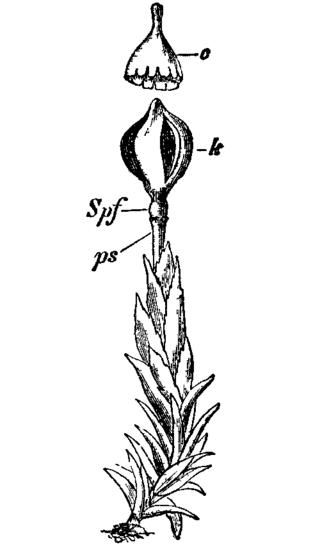
Andreaeaceae is a family of mosses which includes two genera, Andreaea, containing about 100 species, and the genus Acroschisma. The Andreaeaceae prefer rocky habitats ranging from tropical to arctic climates, on which they form tufted colonies, typically with reddish to blackish shoots. The capsules lack the peristome mechanism and dehisce longitudinally to release the spores, resulting in a paper-lantern appearance.
Aschisma kansanum is a species of moss in the family Pottiaceae. It is endemic to the United States. Its natural habitat is temperate grassland. It is threatened by habitat loss.
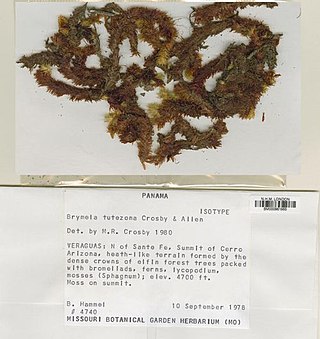
Brymela tutezona is a species of mosses in the family Pilotrichaceae. It is endemic to Panama. Its natural habitat is subtropical or tropical moist lowland forests. It is threatened by habitat loss.

Pottiales is an order of mosses in the subclass Dicranidae.

Jaffueliobryum is a genus of moss in family Ptychomitriaceae.
Lepidopilum grevilleanum is a species of moss in the Pilotrichaceae family. It is endemic to Ecuador. Its natural habitat is subtropical or tropical moist lowland forests. It is threatened by habitat loss.
Leucoperichaetium is a genus of moss in family Grimmiaceae.
Mamillariella geniculata is a species of moss in the family Leskeaceae. It is endemic to Russia, where it is an endangered species known from only five to seven locations in the Russian Far East. It grows in deciduous forest habitat which is threatened by development.
Renauldia lycopodioides is a species of moss in the family Pterobryaceae. It is endemic to Tanzania, where it is known from only two locations and is considered an endangered species. It grows on tree branches in forested habitat. It is threatened by deforestation.
Taxitheliella richardsii is a species of moss in the family Pylaisiadelphaceae. It is endemic to Borneo where it is confined to Sarawak. Its natural habitat is subtropical or tropical dry forests. It is threatened by habitat loss.
Taxitheliella is a genus of moss in family Pylaisadelphaceae.
Andreaeobryum is a genus of moss with a single species Andreaeobryum macrosporum, endemic to Alaska and western Canada. The genus is placed as a separate family, order and class among the mosses.
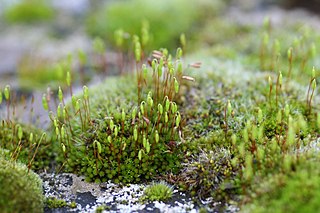
Bryales is an order of mosses.

Bryaceae is a family of mosses.
Chaetomitrium elegans is a species of mosses in the genus Chaetomitrium and family Symphyodontaceae.

Calliergon cordifolium is a species of moss in the Calliergonaceae family, commonly known as the calliergon moss or heart-leaved spearmoss. The species is abundant in the right habitat, and grows in marshes and wet woodland, especially woodland of alder (Alnus) or willow (Salix), as well as around streams, ditches and pools. The species grows in tufts among other moss species. Calliergon cordifolium requires a wet environment to grow, and often grows completely submerged in water. It typically prefers lowland, but has been recorded as high as 910 metres (1,000 yd) above sea level in Inverness, Scotland. The species has a circumpolar Boreo-temperate distribution. It is found throughout Europe. It has been recorded in north and central Asia, as well as Turkey and Japan, throughout North America and in New Zealand.
Distichophyllum carinatum is a species of moss in the family Daltoniaceae. It is native to Europe and Asia, where it has a disjunct distribution. It is known to occur in Germany, China, and Japan. It is also known from Austria and Switzerland, but it may be extinct there today. It is very uncommon where it still occurs, growing in only four locations. It is listed as an endangered species by the International Union for Conservation of Nature.
Amblytropis is a genus of moss in family Pilotrichaceae.
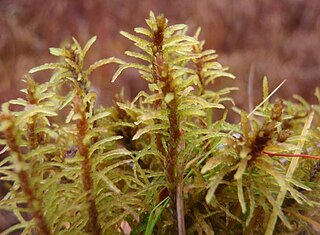
Helodium is a genus of mosses belonging to the family Helodiaceae.
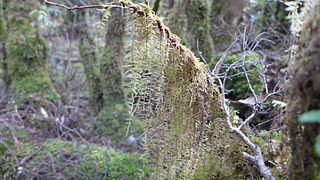
Wijkia is a genus of mosses belonging to the family Pylaisiadelphaceae.









